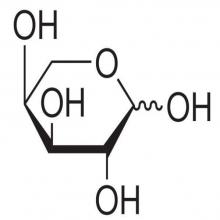L-Arabinose
If you have any other questions ( About The Product Price & Complete COA ), please let us know, we will try to meet your needs.
Product Details
| Name | L-Arabinose |
| Alias | Pectinose |
| CAS No. | 87-72-9; 5328-37-0 |
| Formula | C5H10O5 |
| Weight | 150.13 g/mol |
| Usage | Pharmaceuticals / Use in biology |
| Appearance | White crystal powder |
Product Description
L-arabinose, also known as gum Arabin, pectin; is an aldopentose.
Arabinose(Arabinose gets its name from gum arabic, from which it was first isolated. a kind of L-monosaccharide originally isolated from a colloid secreted by Arab trees by complex chemical and physical methods, natural L-arabinose Rarely exists as free.) is an aldopentose – a monosaccharide containing five carbon atoms, and including an aldehyde (CHO) functional group. For biosynthetic reasons, most saccharides are almost always more abundant in nature as the " D "-form, or structurally analogous to D - glyceraldehyde. However, L -arabinose is, in fact, more common than D -arabinose in nature and is found in nature as a component of biopolymers such as hemicellulose and pectin.
In nature, L-arabinose is rarely present in the form of monosaccharides, usually combined with other monosaccharides, in the form of heteropolysaccharides in colloid, hemicellulose, pectic acid, bacterial polysaccharides, and certain glycosides
L-arabinose, a new type of low-calorie sweetener, widely found in the skin of fruits and whole grains, because it can inhibit the activity of sucrose in the human intestinal tract, thereby inhibiting the absorption of sucrose; in addition, L- Arabinose can also inhibit body fat accumulation and can, therefore, be used to prevent diseases such as obesity, high blood pressure, and high blood fat. In the Ministry of Health and Welfare of Japan, L-arabinose was listed as a “special health food additive for regulating blood sugar”; the American Medical Association listed L-arabinose as “anti-obesity nutritional supplement or over-the-counter medicine”; after that, the Ministry of Health of China in 2008 The official approval of L-arabinose as a new resource food confirmed its important position in the field of functional sugar.
There are two main functions of L-arabinose(It has high stability to heat and acid.) in food and medicine:
One is an enzyme capable of inhibiting hydrolysis of disaccharides, thereby suppressing an increase in blood sugar caused by ingestion of sucrose (which is absorbed by decomposition of glucose and fructose by the action of small intestine sucrase); and a hypoglycemic effect of inhibiting hydrolysis of disaccharide.
On the other hand, due to the inhibitory effect of L-arabinose on the disaccharide hydrolase, the sucrose which is not decomposed in the small intestine is decomposed by microorganisms in the large intestine to produce a large amount of organic acid, which has an inhibitory effect on liver synthesis of fat. In addition, L-arabinose can selectively affect the invertase which digests sucrose in the intestinal disaccharide hydrolase, inhibits the absorption of sucrose, thereby reducing the production of new fat in the body.
L-arabinose can be used in combination with sucrose or alone. Adding 3.5% to sucrose can inhibit the absorption of 60-70% sucrose in human body, and long-term use can lower blood sugar. Eating L-arabinose alone has the same effect.
First, inhibit metabolism and absorption
The most representative physiological role of L-arabinose is to selectively affect the sucrase in the small intestine, thereby inhibiting the absorption of sucrose. It has been reported that the addition of 3.5% L-arabinose to sucrose can inhibit the absorption of 60-70% sucrose and also increase the blood sugar level by about 50%.
Second, inhibition of blood sugar, fat
L-arabinose, a low-calorie sugar, inhibits the rise in blood sugar caused by ingestion of sucrose, thereby inhibiting obesity and preventing and treating diseases associated with hyperglycemia.
Third, prevention of constipation
According to Japanese research, women with constipation tendencies added 3% L-arabinose sucrose to their drinks such as black tea, and the number of bowel movements per week increased significantly. According to tests by Sanhe Starch Co., Ltd., the ingestion of 5% sucrose with 5% arabinose can also effectively promote the growth of Bifidobacterium. L-arabinose itself is a sugar that is difficult to be absorbed by the digestive tract, and a portion that is not used in the body can be excreted from the urine.
Fourth, the impact on skeletal muscle composition
A 2005 study in Japan demonstrated the effects of L-arabinose on energy expenditure and muscle fiber composition by feeding 20% sucrose diet (Group C) and 1.5% L-arabinose to obese rats. % of the cane meal (group A) for 21 weeks. The abdominal adipose tissue weight and cell size of the rats in group C increased significantly, while the fat weight and cell size of group A rats were significantly inhibited. L-arabinose significantly inhibited the rise in blood glucose after 2 hours of glucose administration. When evaluated by respiratory quotient, the percentage of energy consumed by fat in group A increased by 12.8%. The number of type I fibers in the rectus abdominis muscle was significantly increased. Like other skeletal muscles, the rectus abdominis muscle is also composed of type I and type II muscle fibers. These results suggest that L-arabinose has the effect of altering skeletal muscle fiber components, affecting the growth of abdominal adipose tissue by controlling glycolysis to sugar oxidation. This change in muscle fiber ratio may have an effect on improving type 2 diabetes.
n synthetic biology, arabinose is often used as a one-way or reversible switch for protein expression under the P bad promoter in E. coli.This on-switch can be negated by the presence of glucose or reversed off by the addition of glucose in the culture medium which is a form of catabolite repression.Arabinose is a potential prebiotic because it cannot be absorbed by the human intestine and could be utilized by probiotics such as bifidobacteria. This claim requires further validation.
The application prospect of L-arabinose is broad:
First, the application of L-arabinose in baked goods.
L-arabinose has a stable molecular structure and is not decomposed at high temperatures, so it can be used in baked goods. Soft cookies are a kind of biscuits that Americans love, but they are high in sugar and easy to cause obesity. Therefore, adding L-arabinose to such biscuits can inhibit the absorption of sucrose and reduce the obesity of high-sugar biscuits. fear. Similarly, the addition of a certain amount of L-arabinose to baked goods such as cakes and egg yolks in high-calorie foods can reduce the unit energy density to attract more consumers. Since the molecular structure of L-arabinose contains an aldehyde group, it is a reducing monosaccharide. When it is mixed with sucrose to prepare a baked food, it will react with the amino acid, protein, and other substances in the dough to make a browning reaction. The flavor is more unique and the color is more beautiful. In addition, the amount of L-arabinose added in the baked food can generally be determined according to the actual situation, usually not more than 5%, and the addition of L-arabinose can affect the rheological properties, mouthfeel, processing technology, etc. of the dough, so that The baked goods produced are more delicious. Adding L-arabinose to fried foods such as fried chicken, roast chicken, grilled meat, etc. will give it a richer aroma and attractive color.
Second, the application of L-arabinose in beverages.
With the improvement of people's living standards, consumers' health awareness has gradually strengthened, and people's beverage structure has also undergone significant changes. The market for high-calorie beverages has been declining year by year, low-sugar drinks, sugar-free drinks, tea drinks, milk-containing drinks, plants. Nutritional, health-care, and functional beverages such as protein beverages, fruit, and vegetable juice beverages have gradually become the mainstream of the market. The addition of L-arabinose products in various beverages is in line with people's needs.
Third, the application of L-arabinose in biomedicine.
Hepatitis is one of the most prominent public health problems in the world. It is a serious disease that affects people's lives and causes related economic and social problems. Hepatitis virus is the main cause of hepatitis disease. There are six types of hepatitis viruses that have been classified so far. That is, the hepatitis A virus, hepatitis B virus, hepatitis C virus, hepatitis D virus, hepatitis E virus, and hepatitis G virus. Among them, the hepatitis B virus is the virus most infecting humans and the most harmful hepatitis virus. About 2 billion people worldwide have been infected with HBV. About 1 million people die each year from liver failure, liver cirrhosis and primary hepatocellular carcinoma (HCC) caused by HBV infection. Hepatitis C virus (HCV) also causes humans. One of the major viruses of acute hepatitis and chronic liver disease (including cirrhosis and liver cancer), it is estimated that 170 million people worldwide are chronically infected with HCV, 10 to 20% of them will develop cirrhosis, and 1 to 5% will be at 20%. After 30 years, it has developed into liver cancer. Therefore, hepatitis B caused by HBV and hepatitis C caused by HCV are the two most serious viral hepatitis in the world. It is precisely because of the serious harm of hepatitis B and hepatitis C. Among the current anti-hepatitis virus drugs, whether they are listed or under research, these two types of viral hepatitis are the main ones. L-arabinose can be used to synthesize antiviral drugs such as nucleoside analogs, and L-arabinose is used as raw material to synthesize 2-deoxy-2-fluoro-5-methyl-β-L-arabinofuranosyluracil ( L-FMAU). L-FMAU is an effective anti-hepatitis B virus (HBV) and anti-Ep-stein-Barr virus active agent. It is understood that there are five new anti-hepatitis B drugs in phase III clinical trials, two of which use L-arabinose as raw material: the new drug Clevudine (L-FMAU, pyrimidine nucleotide analogue) developed by Bukwang, Korea. The new drug Telbivudine (a type of L-nucleoside analogue) issued by Idenix Pharmaceuticals Inc. in the United States, two new antiviral drugs for the treatment of hepatitis B, telbivudine and koviffin, have been marketed in the United States and South Korea, respectively. The core structure is a nucleoside analogue derived from L-arabinose, which has the characteristics of specifically inhibiting hepadnavirus, not affecting DNA polymerase and mitochondrial function, high selectivity, low toxicity, etc. ,Market prospects.
Fourth, the application of L-arabinose in other fields.
Using L-arabinose as raw material, a rare sugar alcohol, arabitol, can be prepared by hydrogenation synthesis reaction for microbial fermentation and genetic improvement experiments. It can also be used to synthesize anti-AIDS, anti-viral and anti-cancer drugs. The important pharmaceutical intermediate - L-ribose; can also produce arabinose-reactive flavors that produce a soft, rich aroma.
Application field
Food and health products
- Diabetic food
- Diet food
- Healthy functional food
- Sucrose additive
- Healthy food
drug
- As a prescription for weight loss and blood sugar control
- Over-the-counter drug additive or drug-based excipient
- An ideal intermediate for the synthesis of flavors and fragrances
- As an intermediate in drug synthesis
L-arabinose is a naturally occurring isomer.
For sugars, the D/L nomenclature does not refer to the molecule's optical rotation properties but to its structural analogy to glyceraldehyde.
Lactulose is a non-absorbable sugar used in the treatment of constipation and hepatic encephalopathy.
Disclaimer: the information on this website is from the internet for reference only. Please refer to the actual instructions attached to the product and the final interpretation is owned by the company.
Send inquiry online For more product information and prices
(Pharmaceutical Ingredients Manufacturer & Supplier & Exporter.)
After sending the online inquiry, we will reply you as soon as possible, if not get any response on time please contact us by Tel or Email. —— Green Stone Swiss
Email: sales@raw-pharmaceutical-materials.comTel: +86 592 5365887
WhatsApp: +86 189 6515 7632
Send inquiry online:


